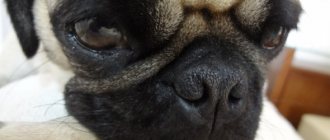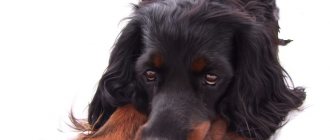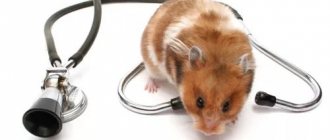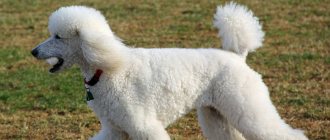Cracks and breaking off claws (Fissura et fractura unquis) in dogs.
Claw cracks are caused by traumatization, which leads to the development of purulent inflammation and the loss of the latter. Breaking of claws is observed in cases of snagging on hard objects. In this case, the supporting type of lameness is immediately noted, and palpation reveals pain in the corresponding toe; often complete separation of the claw.
Treatment of dogs. In some cases, positive results are observed after cutting off the sharp ends of the claws and their cracks with a narrow knife blade, followed by covering the defect with ordinary or epoxy resin. This measure often allows you to save the dog’s claws.
If the base of the skin of the claw and corolla is damaged, the paws are cleaned with antiseptic solutions, dried, lubricated with an alcohol solution of iodine, scraps of tissue and hangnails are removed with scissors, treated with antiseptic powders (streptocide, boric acid mixed with potassium permanganate) or antiseptic aerosols (cubatol, ungutil) and apply a protective bandage. To protect a damaged paw, indoor dogs can be recommended to wear a homemade shoe made of thick tarpaulin reinforced with lacing at the back.
Inflammation of the crown of the claw in dogs.
Inflammation of the crown of the claw (“claw-eater”) (Panaritium) is a very serious disease that occurs as a result of bruised wounds with subsequent complications of surgical infection. It can also develop during the transition of a purulent inflammatory process from surrounding tissues. Purulent inflammation tends to progress, spreading to deeper tissues (subcutaneous tissue, tendons, joints), which leads to rejection of the claws.
Clinical signs are accompanied by severe lameness, swelling of the affected fingers, pain, and increased local temperature. The skin around the claws is very red, often with a purple tint; the claws lack their characteristic shine, wobble and fall off. A sick animal experiences a loss of appetite and an increase in general temperature.
Treatment of dogs. Warm antiseptic baths with potassium permanganate, warming alcohol-ichthyol compresses, a circular novocaine-antibiotic block, bandages with liquid Vishnevsky ointment or ointment containing antibiotics are used. In advanced cases, the claws and affected phalanges of the fingers are resected. This operation is performed under local interdigital infiltration anesthesia with a 0.25-0.5% solution of novocaine, which is injected directly into the interdigital skin fold, 3-5 ml per finger (Fig. 38). Then, within the healthy tissue, a circular incision is made to the bone, which is crossed with bone forceps. A finger can also be amputated through the joint. After the bleeding has stopped, the wound is closed with an interrupted suture, and a protective bandage is applied over it.
Diseases by symptoms and manifestations
Often, more information is provided not by the place of its manifestation, but by the symptoms that develop at the same time.
Paralysis, paws are taken away (fail), the dog may fall
When an animal has paralysis, its paws are taken away (fail), and the dog may fall, this only indicates serious pathologies:
- Severe, advanced forms of dysplasia.
- Damage and displacement of intervertebral discs, as well as their hernial pathologies.
- Advanced arthritis and arthrosis.
If there are no external signs of joint damage (swelling, pain), then we can talk about damage to the central nervous system due to infectious diseases or severe poisoning. Therefore, if such symptoms appear, your pet should be immediately shown to a veterinarian.
The legs are weak, the dog cannot stand
The diseases listed above and a similar “clinic” can occur with myositis, i.e. inflammation of the muscles of the limbs. In this case, the entire paw is painful on palpation, the muscles are tense and hot. It can be treated with antibiotics and physiotherapy, but in order to clarify the diagnosis, the pet must be shown to a veterinarian in any case.
Ulcers and wounds of various etiologies, paws fester
If ulcers and wounds of various etiologies appear on the limbs, the paws are festering, then there is no need to think about the causes of lameness: they are already before your eyes. Determining the cause of such phenomena is somewhat more difficult:
- This may be a simple injury (including splitting and breaking of a claw), complicated by the intervention of a secondary pathogenic microflora.
- This is how many dermatitis and eczema manifest themselves.
- Perhaps this is an advanced fungal infection.
- Paws often fester during felon.
- The joints themselves can fester only in very advanced cases of aseptic arthritis.
Rubs (bruises) and wounds of the crumbs in dogs.
Crumb wounds (Contusiones et vulnus plantares) most often occur in hunting, working (sled) and special service dogs during their long run on uneven, frozen soil, stubble, on snow covered with an icy crust (“trimming” paws), on the road , sprinkled with coarse sand, etc.
Clinical signs are characterized by reluctance or even inability to move. When moving, dogs are careful and afraid to lean on damaged paws. Palpation and examination of the crumbs reveal pain, fever, abrasions, scratches and wounds. Burns of the crumbs may also be observed due to their contact with lime during slaking, hot water, alkalis and acids, which are often accompanied by rejection of the skin of the crumbs with the formation of long-term non-healing ulcers.
Treatment of dogs. The animal is given rest. In all cases, before providing medical assistance to the dog, a thorough examination of the affected paw is carried out to detect foreign bodies (shards of glass, pieces of wire, wood, etc.), which are immediately removed, toileting and surgical treatment of the wounds are carried out, followed by the application of an antiseptic bandage. It is advisable to treat abrasions and scratches with aerosol film-forming antiseptics - kubatol, chronicin, or powder them with streptocide, iodoform, xeroform and apply a protective bandage. For stretches accompanied by severe pain, cold compresses are used.
Inflammation of the tissues of the arch and interdigital space in dogs.
Inflammation of the tissues of the arch and interdigital space (Inflammatio interdigitale) is due to the same reasons as with tenderness and wounds of the crumbs. Dogs with abnormally elongated fetters and splayed paws (flat feet, open paws) are predisposed to it. In addition, inflammation of the tissues of the arch and interdigital space can occur as a result of chills during prolonged tethering on wet soil and especially on an asphalt or cement floor in cold rainy weather. The inflammatory process can proceed aseptically with severe lameness, local redness and swelling of the skin, but when the cause of the disease is eliminated, it quickly subsides and recovery occurs. However, in the case of the introduction of pathogens of purulent infection, purulent inflammatory processes, ulcers and eczema can sometimes develop.
Treatment of dogs is antiseptic, similar to that used for felon and mechanical damage to the crumbs. To prevent the dog from licking its paws, treat it with aloe tincture. For significant lesions, antiseptic bandages are applied or specially made protective shoes are put on.
What are the dangers of paw injuries?
More often, other diseases and injuries are recorded in dogs. They are partly caused by breed characteristics or external conditions, sometimes the causative agent is bacteria or infection.
Inflammation of the interdigital space
Inflammation of the tissues on the paws, especially between the toes and on the pads, causes severe discomfort. Causes:
- long walks on uneven terrain;
- infection of an open wound;
- standing on cold asphalt;
- damp weather.
The pet begins to lick its paw frequently, and pus may be released. The inflammation needs to be treated with a disinfectant, an ointment applied for healing, or aloe tincture can be applied. Be sure to cover it with a protective bandage, and also temporarily limit the duration of walks (until complete healing).
Claweater
This is the name for inflammation of the claw bursa. This leads to rejection of the plate itself, as well as the tissues nearby. Symptoms:
- elevated temperature;
- redness, sometimes cyanosis;
- claw delamination or rejection;
- soreness.
Sometimes the condition spreads from neighboring tissues. Treatment of paws in dogs with clawfoot: treatment with antiseptics, warm baths with soothing and disinfectants, protective bandage. Unfortunately, if the disease is at a late stage, the claws will have to be removed.
Hygroma of the elbow
Inflammation in the ulnar bursa is painless and does not cause lameness. Liquid accumulates there, and the elbow can reach the size of a chicken egg. It is more often observed in heavy breeds with skeletal features during selection. But the accumulation of fluid is also provoked by internal inflammation.
Then they pump out the liquid from the bag with a syringe, inject iodine into it, and wait for positive dynamics. If the procedure does not produce results, the mucous bursa will have to be surgically removed.
Crumb wounds
The crumb, also known as the pad of the finger, is subject to heavy load. When walking or playing, he is injured by sharp stones, sticks, or glass. And due to direct contact with the soil it becomes infected. Sometimes a small stone gets stuck in the crumb, which causes inflammation. How to understand that something is wrong with the pillow:
- the pet walks with caution, limps;
- the dog often licks its paw;
- upon examination she is hot, there are signs of injury;
- soreness.
If there is a foreign body there, it needs to be found, processed and removed. If the nature of the condition is not obvious, consult a doctor. Then you need rest, treatment of the wound and its healing. For a walk, the wounded paw is covered with a barrier bandage.
Eczema in dogs
Eczema between the toes (Eczema interdigitale) is widespread in hunting dogs and is manifested by inflammation of only the superficial layers of the skin between the toes with the formation of a rash.
Etiology. Skin irritation by various plant thorns, thorns, pine needles, nettles, etc.
Clinical signs begin with the formation of a blistering rash, which subsequently, with the opening of the blisters, turns into weeping eczema (wetting stage), and the inflammatory process drags on for a long time. The disease is accompanied by difficulties in the movement of dogs due to soreness of the skin in the interdigital spaces and at the ends of the fingers.
Treatment of dogs. A thorough toilet of the paw is carried out, followed by treatment with astringents and drying substances: 1% solution of brilliant green, 10% solution of iodoform ether, zinc ointment, aerosols of ungutil, cubatol, etc.
Clinical picture
It is heterogeneous and depends on the root cause that caused the development of the disease. So, if there is some kind of infectious pathology, the pads and paws become noticeably red and may swell, and the local tissue temperature is increased. In these cases, you can see nodules (papules) or pustules, notice ulcers or discharge of pus (visible in the photo). If the disease is advanced, the animal’s legs often become bald.
What if pododermatitis has an allergic background? The skin on the paws is also red and swollen, but an increase in local body temperature is usually not recorded. The hallmark is severe itching, which causes the dog to constantly rub and lick its limbs. If interdigital pododermatitis in dogs develops as a result of an allergy, then the dog can spend hours rubbing its paws in its mouth. As a result, the skin on them becomes macerated, and massive hair loss begins. The remaining fur on the paws is all sticky and important from a large amount of saliva.
Please note: if you are dealing with a contact variant of the disease that has arisen as a result of direct contact with allergens or toxic substances, then the lesions are fixed on the paw pads themselves. When the cause is a general allergic reaction, then signs of pathology are visible not only on the paws, but also on the face, as well as the ears.
Our little brothers, just like people, suffer from many diseases of various etiologies. One of the most common ailments is pododermatitis - an inflammatory process that develops mainly on the pet’s limbs, in places of contact with the ground (interdigital spaces, paw pads).
In addition, there is a genetic predisposition to this disease that is characteristic of a particular breed. For example, Shar Peis often suffer from pododermatitis.
, bulldogs, Pekingese, German shepherds, dachshunds, Labradors.
Radial nerve palsy in dogs
Radial nerve palsy (Paralysis nervi radialis) occurs in dogs much more often compared to diseases of other nerves of the extremities.
The causes of this paralysis are mainly bruises, as well as excessive muscle strain, especially in hounds and working dogs. Due to mechanical damage to the radial nerve, the function of the triceps brachii muscle, which is a powerful extensor of the thoracic limb, is lost. Therefore, all distal joints will be in a flexed position.
Clinical signs of the disease are manifested by extension of the shoulder, lowering of the elbow and flexion of the wrist and phalangeal joints. Support on the affected limb becomes impossible due to flexion of all joints of the limb (except for the scapulohumeral joint).
The prognosis ranges from cautious to unfavorable in advanced cases.
Treatment of dogs. Massage, galvanization with novocaine iophoresis, heating, Solux, Minin lamps, irradiation with ultraviolet rays, darsonvalization along the radial nerve are used. Intramuscular injections of B vitamins (B1 B2), prozerin or dibazol are performed daily, alternating for a month.
Limb amputation in dogs
Amputation of a limb (Amputatio extremitatis). Indications for this operation in dogs are injuries associated with crushing the tissues of the limb, as well as diseases manifested by the development of gangrene, osteomyelitis, etc.
Limb amputation is performed under anesthesia or neuroleptanalgesia. A tourniquet is applied to the amputated limb above the surgical site. Tissues in the shoulder or thigh area are separated with a circular incision, and on the distal sections of the limbs with a circular or patchwork one (Fig. 40). First, the skin is cut, and then all other tissues are cut down to the bone. After this, all disconnected tissues are separated from the bone, using a tampon, they are moved upward by 3-5 cm and isolated with sterile napkins. The exposed bone, after preliminary separation of the periosteum, is separated with a surgical saw. Then the tourniquet is loosened, large blood vessels are ligated and small bleeding blood vessels are torsioned. The bone marrow is partially removed with a sharp spoon to a depth of 0.5 cm and the soft tissue is shifted down, covering the exposed bone. The formation of the stump is carried out by suturing the muscles and fascia below the bone cut with loop-shaped sutures made of catgut, and the skin underneath is connected with an interrupted suture. A bandage is applied to the resulting stump.
After healing of the surgical wound, despite the complete loss of support function, dogs move quite tolerably on three limbs. Therefore, they can be used for their intended purpose, with the exception of hunting dogs - hounds, greyhounds and burrows.
Descriptions of other diseases of the limbs are presented in the relevant sections (diseases of bones, joints, muscles, muscles in dogs, etc.).
Review and description of possible options
It is possible to accurately determine the reason why a dog’s finger is swollen only when the moment of injury comes into view.
In all other cases, a series of diagnostic measures will be required, ranging from an external examination to a fine-needle biopsy. This is done to exclude the following reasons.
Foreign body
Very often dogs suffer from splinters getting into their fingers. They can be of natural origin (thorns from weeds, wood chips, needles from coniferous trees) or industrial (small nails, wire, needles from syringes, etc.).
If a splinter gets under the skin, it causes a lot of discomfort to the pet while walking, which causes lameness. If the foreign body is not removed in time, an inflammatory process will begin, due to which the animal will completely stop stepping on its paw.
During the inflammatory process, the fingers swell, the skin turns red, and an abscess forms. If you cannot remove the splinter yourself, it is better to seek help from a surgeon. And the sooner the better. Since the abscess will increase in size, which will complicate the operation.
The lesion is opened, cleaned of blood clots and pus, treated with an antiseptic and drainage is applied. In the next 3-5 days, the owner will have to do the same thing himself. Only instead of installing drainage, levomekol is applied to the affected area and covered with a bandage. The healing process may take 5 to 10 days.
Injury
The most common reason why a dog's finger may become swollen and red. You can get injured during a game, a fight, a fall from a height or a walk. In most cases, minor injuries go away within a few days even without the use of any ointments.
Provided that there is no inflammation, dislocation or fracture. But, separately, I would like to talk about the dewclaw, which is very often injured. This is especially true for hunting breeds, which spend most of their lives among forests and tall grass. So, they most often have problems with their dewclaws, as they constantly cling to the branches of bushes and weeds. Because of this, the fifth finger becomes swollen, red and extremely painful. The pet may begin to limp.
It is advisable to immediately treat the wound with miramistin or chlorhexidine for disinfection and make a bandage soaked in levomekol. Do not allow the animal to lick the affected area under any circumstances. It is because of such problems that hunting breeds have their dewclaws removed as early as puppyhood. But this is only at the discretion of the owner, there are no medical indications for this. This is considered a cosmetic defect.
Fracture
You can get it out of the blue, in seemingly the simplest situation. But, usually, fractures occur during training, walks, games with relatives and fights. When a fracture occurs, the finger always swells and hurts terribly.
The only thing the owner can do in this situation is to try to prevent the animal from stepping on the affected limb before arriving at the clinic. They will definitely do an x-ray, palpation (if necessary) and an external examination.
Based on the complexity of the fracture, fixing bandages are applied. In severe cases, the bone is harvested through surgery.
Dislocation
Just like a fracture can occur during any active actions. If you have a dislocation, you should never try to straighten the affected limb yourself. If something goes wrong, your pet will experience terrible pain.
The owner's task is to immediately deliver the animal to a veterinary clinic where there is an orthopedic surgeon. In this case, it is necessary to limit the dog’s access to the affected limb so that it does not aggravate the injury. After an x-ray, if a fracture is ruled out, the dislocation is reduced, and a fixing bandage is applied to the finger (if necessary).
Ingrown nail
If your dog has a swollen finger near the nail, then you need to exclude the possibility of an inflammatory process. Inflammation can be caused by a nail injury (the pet accidentally tore it off during a walk or the owner accidentally damaged it with a nail clipper during a manicure procedure) or an ingrown nail.
In both cases, you will need the participation of a surgeon, who will most likely remove the problematic nail, clean the wound of pus, treat it with an antiseptic and select effective anti-inflammatory drugs.











